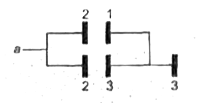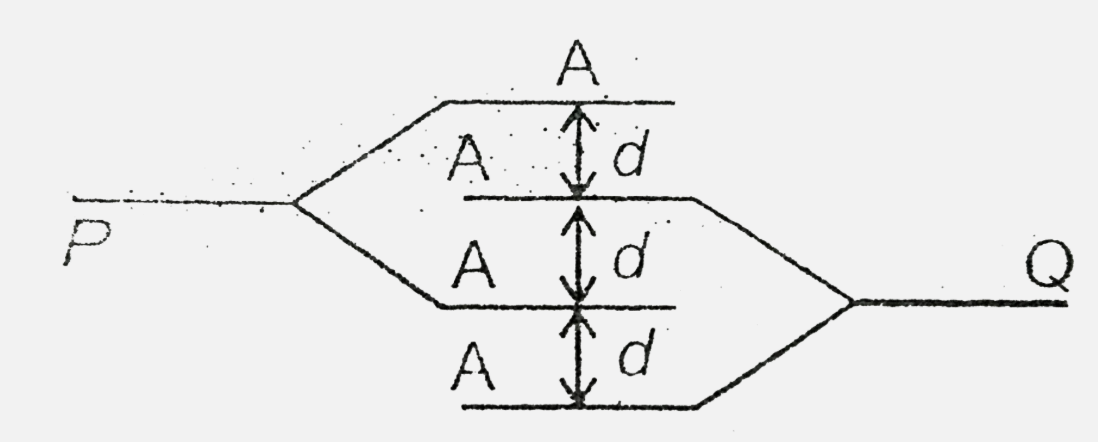Consider the following arrangement of four plates interconnected as follows . Each plate has the area A and the polate separation is d . Here plates 1 and 3 are interconnected . Find the equivalent capacitance between a and b

Note that this kind of arrangement is done when we want to constant more capacitors using less number of plates . In the above arrangement we have in total three capacitors using only four plates (however ordinarily you require six plates to construct three capacitors ). This has been done by sharing the plate 2 with plate 1 and 3 has been shared by plate 2 as well as plate 4 . The method of solving this kind of problem is to sketchthe complete network of three capacitors showing each of three capacitors separately.

Here plate 2 and plate 3 are being shared by twop adjacent plates so in the diagram they will appear twice . Remember you have to show three capacitors using plate groups 1-2,2-3 and ,3-4 . First start with point a and you can see it is connected to plate 2 and plate has to appear twice in your network because it is being shared with plate 1 and 3 . So draw it as shown :
Now since plate 1 is on one side of plate 2 and plate 3 on the other side. draw them in front of plate 2 as shown :

Now you see plate 1 and 3 are inter connected so join them as follow :

Then you see that even plate 3 is being shared by two plates viz . plate 2 and 4 . So plate 3 should also appear twice in your diagram as shown below:

Now you note that plate 4 is in front of plate 3 and 4 is connected to point b . so draw it as follows :

So your final diagram has three capacitors each of capacitance C in which two are connected in parallel and in series with the third one as shown :

Hence the final capacitance is
Topper's Solved these Questions
- ELECTROSTATIC POTENTIAL AND CAPACITANCE BOOK - AAKASH INSTITUTECHAPTER - ELECTROSTATIC POTENTIAL AND CAPACITANCE EXERCISE - TRY YOURSELF
110 Videos
- ELECTROSTATIC POTENTIAL AND CAPACITANCE BOOK - AAKASH INSTITUTECHAPTER - ELECTROSTATIC POTENTIAL AND CAPACITANCE EXERCISE - ASSIGNMENT (SECTION-A) Objective Type Questions (Only one answer)
47 Videos
- ELECTROMAGNETIC WAVESBOOK - AAKASH INSTITUTECHAPTER - ELECTROMAGNETIC WAVESEXERCISE - ASSIGNMENT SECTION - D Assertion-Reason Type Questions
25 Videos
- GRAVITATION BOOK - AAKASH INSTITUTECHAPTER - GRAVITATION EXERCISE - ASSIGNMENT SECTION - D (ASSERTION-REASON TYPE QUESTIONS)
16 Videos
Similar Questions
Knowledge Check
Six plates of equal area A and plate separation as shown in figure as shown are arranged. The equivalent capacitance between A and B is
 Aε0AdB2ε0AdC3ε0AdDε0Ad
Aε0AdB2ε0AdC3ε0AdDε0AdSix plates each of area A arranged as shown· in figure. The separation between adjoining plates is d. Find the equivalent capacitance between points A and B :
 Aε0AdB7ε0AdC6ε0AdD5ε0Ad
Aε0AdB7ε0AdC6ε0AdD5ε0AdFour square plates, each with edge length a, are arranged as shown in the following figure. The equivalent capacitance between A and C is
 A3ε0a25dB3ε0a22dC2ε0a23dD5ε0a23d
A3ε0a25dB3ε0a22dC2ε0a23dD5ε0a23d
Find out equivalent capacitance between A and B. (take each plate Area = A)

View SolutionFind out equivalent capacitance between A and B. (take each plate Area = A)

View SolutionFind out the capacitance of parallel plate capacitor of plate area A and plate separation d.
View SolutionConsider the following arrangement of four parallel plates with plate area A each. The separation between each consecutive plate is d. The leftmost and rightmost plates are connected by a metal wire. Calculate the effective capacitance between points P and Q.

View SolutionThe following arrangement consists of four plates each of area A. the separation between the consecutive plates is d. what is the ratio of the effective capacitance between P and Q as shown in figures (1) and (2).

View Solution


 .
.